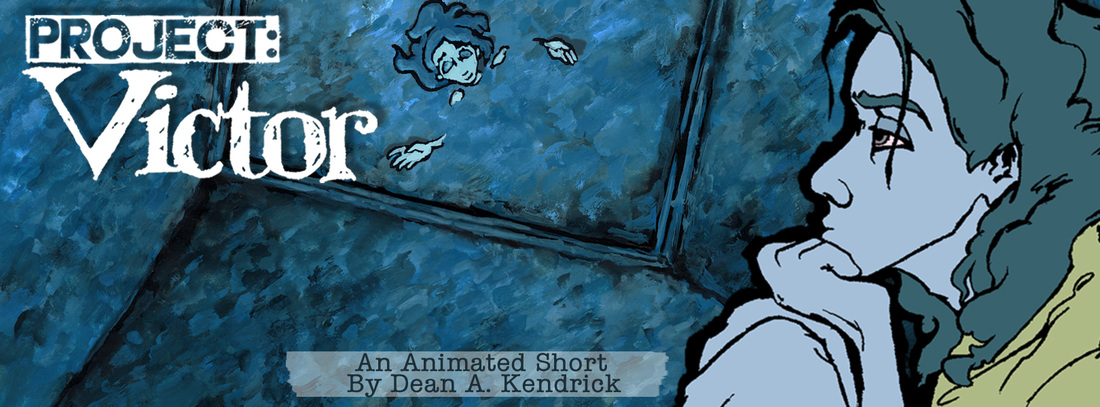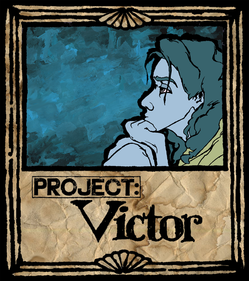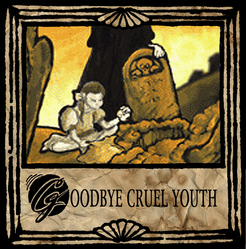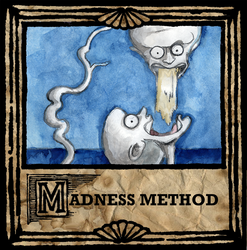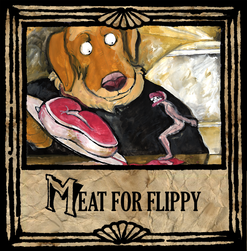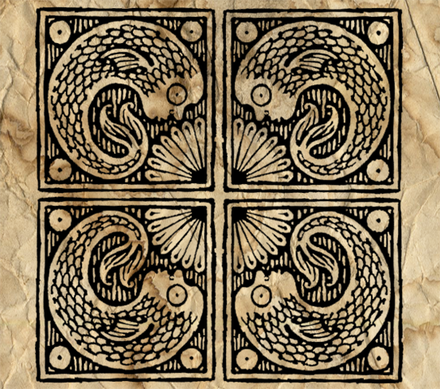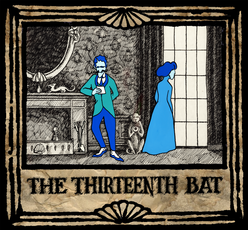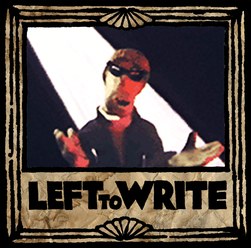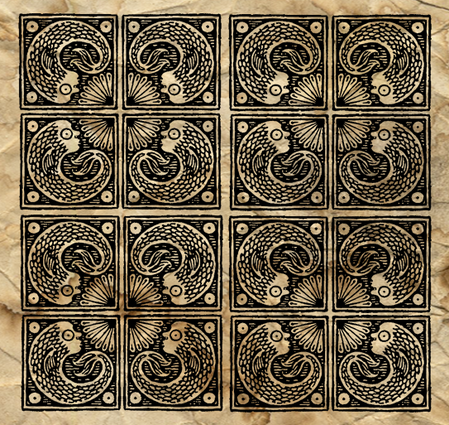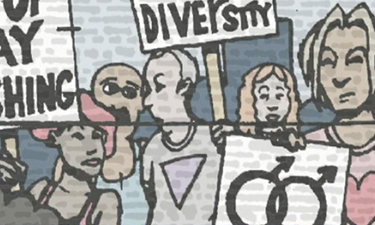
IN PRODUCTION - "PROJECT VICTOR" (tentative title), a 2-D hand-drawn animated digital film by Dean A. Kendrick with music by The Irritants.
This short, animated digital film follows lead character Victor through his romantic infatuation with another young man in the year 2000, a boy-meets-boy story set amidst the American heartland where homosexuality was (and sadly still is) considered deviant and dangerous to a society ruled by a cruel and judgmental, blindly religious moral majority. Victor confronts such feelings as love and lust, wonder and worth, isolation and omnipresent fear about being gay in a world that requires him to hide his true self identity for trepidation of persecution and bodily harm.
The telling of the story is somewhat linear but does not shy away from letting surrealistic imagery and music feed emotions and drive the action. The soundtrack is comprised of original sonic soundscapes, score and songs I have penned with my underground, indie rock ensemble The Irritants. The characters listen to their favorite band's music and sometimes sing along with the tracks, sometimes not.
The majority of the classic style 2-D artwork and animation is being created by myself, and all done by hand with pencil and paint on paper at my apartment studio in Long Beach, CA. The animation is drawn in a fluid, classic-Disney-features style, with no intended 3-D CGI trickery, puppetry or motion capture. The movements are meticulously drawn one drawing at a time, 12 to 24 drawings per one second of film without rotoscoping (tracing live action footage), and for certain scenes the drawings are hand colored with gouache and brush. Each drawing is then digitally scanned, cleaned and colored by a handful of talented assistants who also setup and run the animation and virtual camera moves. Depending on the complexity of a scene, it can take many weeks just to produce several seconds of animation and with a final running time of approximately twelve minutes, well we’re talking years of complex, integral work.
This short, animated digital film follows lead character Victor through his romantic infatuation with another young man in the year 2000, a boy-meets-boy story set amidst the American heartland where homosexuality was (and sadly still is) considered deviant and dangerous to a society ruled by a cruel and judgmental, blindly religious moral majority. Victor confronts such feelings as love and lust, wonder and worth, isolation and omnipresent fear about being gay in a world that requires him to hide his true self identity for trepidation of persecution and bodily harm.
The telling of the story is somewhat linear but does not shy away from letting surrealistic imagery and music feed emotions and drive the action. The soundtrack is comprised of original sonic soundscapes, score and songs I have penned with my underground, indie rock ensemble The Irritants. The characters listen to their favorite band's music and sometimes sing along with the tracks, sometimes not.
The majority of the classic style 2-D artwork and animation is being created by myself, and all done by hand with pencil and paint on paper at my apartment studio in Long Beach, CA. The animation is drawn in a fluid, classic-Disney-features style, with no intended 3-D CGI trickery, puppetry or motion capture. The movements are meticulously drawn one drawing at a time, 12 to 24 drawings per one second of film without rotoscoping (tracing live action footage), and for certain scenes the drawings are hand colored with gouache and brush. Each drawing is then digitally scanned, cleaned and colored by a handful of talented assistants who also setup and run the animation and virtual camera moves. Depending on the complexity of a scene, it can take many weeks just to produce several seconds of animation and with a final running time of approximately twelve minutes, well we’re talking years of complex, integral work.
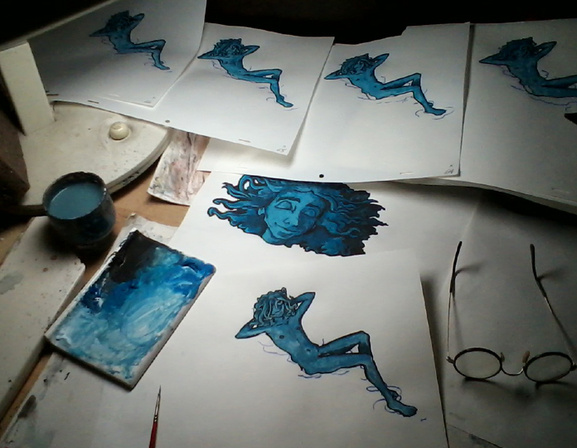
I believe animation is not a genre, nor merely a technique, but rather a true art form. In the United States, animation is unfortunately seen exclusively as either family entertainment or comic satire unlike elsewhere around the world where it is often made with various diverse and intelligent themes by passionate artists and devoted craftspeople, and is hailed and appreciated by audiences and even governmentally funded.
The goal of this film is to present youth sexual identity issues with hopefully, the notion of promoting intelligent discussion and understanding of and for young LGBTQ people and society as a whole. Personally, this is a film that I wish I could have seen when I was a sexually confused young man, actually hearing a voice informing and reassuring me that it was OK to be gay and that I was not alone. I know there are countless others out there who could be comforted by this pure, often revelatory, fundamental news of love." - Dean A. Kendrick
The goal of this film is to present youth sexual identity issues with hopefully, the notion of promoting intelligent discussion and understanding of and for young LGBTQ people and society as a whole. Personally, this is a film that I wish I could have seen when I was a sexually confused young man, actually hearing a voice informing and reassuring me that it was OK to be gay and that I was not alone. I know there are countless others out there who could be comforted by this pure, often revelatory, fundamental news of love." - Dean A. Kendrick

"Queer And Loathing" by David B. Feinberg - 7 Interstitials for the 4 part ITVS Series, "Positive: Life With H.I.V."
©1995 Independent Television Service Running time: each segment approximately 18 seconds to 1 minute, 13 seconds 4:3 color/stereo 2.0 Synopsis: Excerpts from Davis B. Feinberg’s satirical book, “QUEER AND LOATHING”, were prepared as 2D hand drawn animated pieces featuring a caricature of the author. The pieces were used as breaks of levity between sequences of performing artists and interviews with people living with the H.I.V. virus and A.I.D.S. Visit the POSITIVE: LIFE WITH H.I.V" Website. |

"Don't Forget To Bring Your Eyes"
©1993 Dean Kendrick Running time: 4 minutes, 47 seconds 4:3 black and white/stereo 2.0 Synopsis: What is history? Is it truth? What is truth? Is it perspective? What is perspective? Is it history? These and other queries are presented through a series of curiouser and curiouser visuals that invite the viewer to question the origin of beliefs, why they change over time, and what lies beneath the growth of one’s own perceived reality. Or not. Awards and festival showings: 1st Place, Animation category at the 1994 UTAH SHORT FILM AND VIDEO FESTIVAL; 3rd Place, Animation category at the 1994 CENTRAL FLORIDA FILM AND VIDEO FESTIVAL; FEST ANCA 2010: INTERNATIONAL ANIMATION FESTIVAL - Zilina, Slovakia |
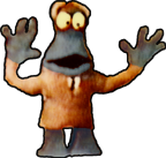
LEFT TO WRITE (1988)
Visual media: Photographed at 24 frames per second on Super-8 millimeter film, which was then transferred to 30 frames per second NTSC standard VHS 1/2inch videocassette tape for editing purposes. Editing was done on a PANASONIC A/B roll VHS video editing system.
Animation techniques: Stop-motion with modeling clay figures on miniature settings, as well as stop-motion with paper cut-outs, photographs, aluminum foil, watercolor marker on washable shelf paper (for THE BOX), viscous paint on glass, and painting directly on human flesh; 2D traditional, hand drawn and painted animation with pencil, marker, acrylic paint, and ink with wooden stick on paper; 2D traditional, hand drawn animation with marker on paper individually cut out and photographed as stop-motion (for the HELL STREET ghosts and THE DRIPPING RAINBOW of PSYCHEDELIA); Individually hand scratched and punctured frames of processed film as well as drawing directly onto the processed film with marker.
Audio: Very cheaply produced on a TASCAM portable 4-track audiocassette tape recorder, edited and mixed down to the two VHS linear tracks and then mixed back through the TASCAM to the VHS master, thus adding two more tracks from audiocassette into the mix, all in real-time. This was done in segments, though usually entire sequences were done at one pass. Visual edits were made to the cues of the mixed soundtrack, now on the VHS master's linear tracks. Lo-fi extravaganza!
Soundtrack: Most of the score was created and performed on that wretched TASCAM 4-track recorder by John Carpender and Jeff Demand, the then unestablished and blossoming band, THE IRRITANTS. Dean's sister, Wendy Kendrick, also contributed music that includes Mr. Right's theme and the music for the BAT SONG (lyrics by Dean), as well as the layered vocal piece that accompanies the film's climax. The character voice talents were provided by any and all friends of Dean who he could persuade into thinking they would become big stars. The sound effects were created by Dean on the TASCAM.
Notes: Beginning in 1984, Dean spent six months writing the story and script and then produced, directed, designed, and animated the piece damn near single handedly over the next four years. The piece was really a self-taught college degree for Dean, who took on more than one person should handle as is evident in the project's raw look and sound, and its crude-to-fair animation inconsistencies. Additional artwork by Jen Gulrajani and Jeff Stout provided increased dementia for THE FUN PART sequence. A re-mastering from VHS to SVHS videocassette was completed in 1992 using the original audiotapes and film-to-videotape transfers.
Visual media: Photographed at 24 frames per second on Super-8 millimeter film, which was then transferred to 30 frames per second NTSC standard VHS 1/2inch videocassette tape for editing purposes. Editing was done on a PANASONIC A/B roll VHS video editing system.
Animation techniques: Stop-motion with modeling clay figures on miniature settings, as well as stop-motion with paper cut-outs, photographs, aluminum foil, watercolor marker on washable shelf paper (for THE BOX), viscous paint on glass, and painting directly on human flesh; 2D traditional, hand drawn and painted animation with pencil, marker, acrylic paint, and ink with wooden stick on paper; 2D traditional, hand drawn animation with marker on paper individually cut out and photographed as stop-motion (for the HELL STREET ghosts and THE DRIPPING RAINBOW of PSYCHEDELIA); Individually hand scratched and punctured frames of processed film as well as drawing directly onto the processed film with marker.
Audio: Very cheaply produced on a TASCAM portable 4-track audiocassette tape recorder, edited and mixed down to the two VHS linear tracks and then mixed back through the TASCAM to the VHS master, thus adding two more tracks from audiocassette into the mix, all in real-time. This was done in segments, though usually entire sequences were done at one pass. Visual edits were made to the cues of the mixed soundtrack, now on the VHS master's linear tracks. Lo-fi extravaganza!
Soundtrack: Most of the score was created and performed on that wretched TASCAM 4-track recorder by John Carpender and Jeff Demand, the then unestablished and blossoming band, THE IRRITANTS. Dean's sister, Wendy Kendrick, also contributed music that includes Mr. Right's theme and the music for the BAT SONG (lyrics by Dean), as well as the layered vocal piece that accompanies the film's climax. The character voice talents were provided by any and all friends of Dean who he could persuade into thinking they would become big stars. The sound effects were created by Dean on the TASCAM.
Notes: Beginning in 1984, Dean spent six months writing the story and script and then produced, directed, designed, and animated the piece damn near single handedly over the next four years. The piece was really a self-taught college degree for Dean, who took on more than one person should handle as is evident in the project's raw look and sound, and its crude-to-fair animation inconsistencies. Additional artwork by Jen Gulrajani and Jeff Stout provided increased dementia for THE FUN PART sequence. A re-mastering from VHS to SVHS videocassette was completed in 1992 using the original audiotapes and film-to-videotape transfers.
THE IRRITANTS EYE WAX (1991)
Visual media: The live-action segments were shot on NTSC standard VHS and SVHS 1/2inch videocassette tape, Super-8 millimeter film, and a FISHER PRICE PIXELVISION toy video camera, which records a low quality, pixilated, black and white image onto an audiocassette tape. The piece was edited and mastered to SVHS videocassette tape on a then newly acquired PANASONIC SVHS A/B roll video editing system.
NOTE: Two methods were used to create the animated segments for THE IRRITANTS EYE WAX. The first method was classic single-frame photography on a Super-8 millimeter film camera, where the animation is created to be played back at the U.S.A. film rate of 24 frames per second. The second method, however, introduced a scheme of creating the animation for video format (at this period in history, the equipment that could videotape in single frames as film cameras do, or any early computer animation system of quality, was available only to large studios who could afford it and completely out of budget for the independent). Since U.S.A. standard playback rate for videotape is 30 frames per second, the animation had to be designed thusly. For traditional 2D hand drawn animation, more drawings were needed for each second of screen time, which made the actions smoother and clearer than film's 24 frames per second rate. Each original drawing was then videotaped on camera in live-action, exposing it for two seconds or so, then removing it and replacing it with the next drawing in succession, complete with on-screen shots of Dean's hands changing the drawings from one to the next. Then, from this source tape to the master tape, one or two video frames of each drawing (without Dean's obstructive hands) are edited end to end in succession until the entire piece was completed. This was especially frustrating for several reasons. One was that the editing machines' capabilities were limited to plus-or-minus two frames, meaning each attempted edit would result in either the frames joining together as intended or landing off mark by one or two frames, sometimes deleting the previously laid frame. The attempts at joining one frame to its successor could take up to ten or more tries, and in the exacting nature of animation, this is intolerable. Another frustration to this method was that insert editing was not possible, meaning if something needed to be changed in the middle of the piece, everything after that spot would be deleted and need to be edited again, frame by frame. Dean had to compile the video frames from the start of the piece to its finish with the scene changes predetermined in his drawings. But the advantage of using this video method was that Dean could see the results more immediately and do short term corrections in the drawings or editing, rather than wait days or weeks for the raw film to be developed at some outside photo lab. Videocassettes were also more cost-friendly than film stock. So, this half-assed, frame-to-frame video editing method became Dean's standard of production for his next four works.
Animation techniques: Stop-motion with humans, modeling clay, paper cut-outs, and objects including a telephone, cooked pasta, a toy car, a LIGHTBRITE toy, black smoke from a not-so-distant tire fire, a wire and masking tape and paper puppet, viscous paint on glass, and an apple; 2D traditional, hand drawn and painted animation with pencil, marker, oil pastel, and watercolor on paper; Individually hand scratched frames of processed film.
Audio: Produced, as was the audio for LEFT TO WRITE, with the exception of substituting the SVHS format for the VHS format (though still horrifically low-fidelity).
Soundtrack: Music and sound effects by THE IRRITANTS (of which Dean was now a member).
Notes: The wacky primitive computer graphics were created by Greg Stout, and that bizarre aging makeup for IT'S MEDICATION TIME was designed and applied by Robert Banks. THE IRRITANTS EYE WAX was re-mastered to digital media at RELEVANT IMPERTINENCE PRODUCTIONS with the audio re-mastered at ULTRASUEDE Studio, both in Cincinnati, during late 2002-early 2003.
Visual media: The live-action segments were shot on NTSC standard VHS and SVHS 1/2inch videocassette tape, Super-8 millimeter film, and a FISHER PRICE PIXELVISION toy video camera, which records a low quality, pixilated, black and white image onto an audiocassette tape. The piece was edited and mastered to SVHS videocassette tape on a then newly acquired PANASONIC SVHS A/B roll video editing system.
NOTE: Two methods were used to create the animated segments for THE IRRITANTS EYE WAX. The first method was classic single-frame photography on a Super-8 millimeter film camera, where the animation is created to be played back at the U.S.A. film rate of 24 frames per second. The second method, however, introduced a scheme of creating the animation for video format (at this period in history, the equipment that could videotape in single frames as film cameras do, or any early computer animation system of quality, was available only to large studios who could afford it and completely out of budget for the independent). Since U.S.A. standard playback rate for videotape is 30 frames per second, the animation had to be designed thusly. For traditional 2D hand drawn animation, more drawings were needed for each second of screen time, which made the actions smoother and clearer than film's 24 frames per second rate. Each original drawing was then videotaped on camera in live-action, exposing it for two seconds or so, then removing it and replacing it with the next drawing in succession, complete with on-screen shots of Dean's hands changing the drawings from one to the next. Then, from this source tape to the master tape, one or two video frames of each drawing (without Dean's obstructive hands) are edited end to end in succession until the entire piece was completed. This was especially frustrating for several reasons. One was that the editing machines' capabilities were limited to plus-or-minus two frames, meaning each attempted edit would result in either the frames joining together as intended or landing off mark by one or two frames, sometimes deleting the previously laid frame. The attempts at joining one frame to its successor could take up to ten or more tries, and in the exacting nature of animation, this is intolerable. Another frustration to this method was that insert editing was not possible, meaning if something needed to be changed in the middle of the piece, everything after that spot would be deleted and need to be edited again, frame by frame. Dean had to compile the video frames from the start of the piece to its finish with the scene changes predetermined in his drawings. But the advantage of using this video method was that Dean could see the results more immediately and do short term corrections in the drawings or editing, rather than wait days or weeks for the raw film to be developed at some outside photo lab. Videocassettes were also more cost-friendly than film stock. So, this half-assed, frame-to-frame video editing method became Dean's standard of production for his next four works.
Animation techniques: Stop-motion with humans, modeling clay, paper cut-outs, and objects including a telephone, cooked pasta, a toy car, a LIGHTBRITE toy, black smoke from a not-so-distant tire fire, a wire and masking tape and paper puppet, viscous paint on glass, and an apple; 2D traditional, hand drawn and painted animation with pencil, marker, oil pastel, and watercolor on paper; Individually hand scratched frames of processed film.
Audio: Produced, as was the audio for LEFT TO WRITE, with the exception of substituting the SVHS format for the VHS format (though still horrifically low-fidelity).
Soundtrack: Music and sound effects by THE IRRITANTS (of which Dean was now a member).
Notes: The wacky primitive computer graphics were created by Greg Stout, and that bizarre aging makeup for IT'S MEDICATION TIME was designed and applied by Robert Banks. THE IRRITANTS EYE WAX was re-mastered to digital media at RELEVANT IMPERTINENCE PRODUCTIONS with the audio re-mastered at ULTRASUEDE Studio, both in Cincinnati, during late 2002-early 2003.
THE THIRTEENTH BAT (1992)
Visual media: Edited frame by frame, 30 frames per second on NTSC standard SVHS 1/2inch videocassette tape (refer to THE IRRITANTS EYE WAX notes).
Animation techniques: 2D traditional, hand prepared cel animation. The backgrounds were created with pen and ink on paper.
Audio: Same bulltwinkie method used for LEFT TO WRITE, but substituting SVHS for VHS, and with a newer model TASCAM 4-track recorder.
Soundtrack: Grand church organ recordings of the music of J. S. Bach played in reverse. The voice talent narrator, Dana Carpender (John's sister), provided a splendid ghostly reading of Dean's rhyming text. The sound effects were homemade on the TASCAM by THE IRRITANTS.
Notes: This piece was inspired by the brilliant, macabre books of Edward Gorey. So much in fact that in hindsight, Dean is dismayed by his visual look for the piece being too close in design to Gorey's illustrations which made it more of a copy than an intended homage. THE THIRTEENTH BAT was re-mastered to digital media at RELEVANT IMPERTINENCE PRODUCTIONS and the original 2 track audio mix was re-mastered by Matt Fry at ULTRASUEDE Studio, both in Cincinnati, during late 2002-early 2003.
Visual media: Edited frame by frame, 30 frames per second on NTSC standard SVHS 1/2inch videocassette tape (refer to THE IRRITANTS EYE WAX notes).
Animation techniques: 2D traditional, hand prepared cel animation. The backgrounds were created with pen and ink on paper.
Audio: Same bulltwinkie method used for LEFT TO WRITE, but substituting SVHS for VHS, and with a newer model TASCAM 4-track recorder.
Soundtrack: Grand church organ recordings of the music of J. S. Bach played in reverse. The voice talent narrator, Dana Carpender (John's sister), provided a splendid ghostly reading of Dean's rhyming text. The sound effects were homemade on the TASCAM by THE IRRITANTS.
Notes: This piece was inspired by the brilliant, macabre books of Edward Gorey. So much in fact that in hindsight, Dean is dismayed by his visual look for the piece being too close in design to Gorey's illustrations which made it more of a copy than an intended homage. THE THIRTEENTH BAT was re-mastered to digital media at RELEVANT IMPERTINENCE PRODUCTIONS and the original 2 track audio mix was re-mastered by Matt Fry at ULTRASUEDE Studio, both in Cincinnati, during late 2002-early 2003.

NUMBERING BAD FRUIT (1992)
Visual media: Edited frame by frame, 30 frames per second on NTSC standard SVHS 1/2inch videocassette tape (refer to THE IRRITANTS EYE WAX notes).
Animation techniques: 2D traditional, hand drawn and painted animation with pen and ink, crayon, and watercolor on paper, incorporating newspaper scraps and electrical tape.
Audio: The same cheesy method used for LEFT TO WRITE, but substituting SVHS for VHS.
Soundtrack: Blame THE IRRITANTS.
Notes: Dean drew this piece on his kitchen table in Lake Bluff, Illinois, over a five-month period with completion in December 1992. This work and the next two, DON'T FORGET TO BRING YOUR EYES and the QUEER AND LOATHING pieces, were actually side projects to the tedious and troublesome cel production, THE RISE AND DEMISE OF GRIZZELDA, which ultimately, with limited technology, became more than Dean could handle on his own. With it near half completed, Dean abandoned it wholly in search of friendlier digital technology to realize future works with improved visual and aural clarity. NUMBERING BAD FRUIT was re-mastered to digital media at RELEVANT IMPERTINENCE PRODUCTIONS, Cincinnati, and the original 2 track audio mix was re-mastered by award-winning sound designer Will Riley at PLANET OF IDIOTS, Hollywood, during late 2002-early 2003.
Visual media: Edited frame by frame, 30 frames per second on NTSC standard SVHS 1/2inch videocassette tape (refer to THE IRRITANTS EYE WAX notes).
Animation techniques: 2D traditional, hand drawn and painted animation with pen and ink, crayon, and watercolor on paper, incorporating newspaper scraps and electrical tape.
Audio: The same cheesy method used for LEFT TO WRITE, but substituting SVHS for VHS.
Soundtrack: Blame THE IRRITANTS.
Notes: Dean drew this piece on his kitchen table in Lake Bluff, Illinois, over a five-month period with completion in December 1992. This work and the next two, DON'T FORGET TO BRING YOUR EYES and the QUEER AND LOATHING pieces, were actually side projects to the tedious and troublesome cel production, THE RISE AND DEMISE OF GRIZZELDA, which ultimately, with limited technology, became more than Dean could handle on his own. With it near half completed, Dean abandoned it wholly in search of friendlier digital technology to realize future works with improved visual and aural clarity. NUMBERING BAD FRUIT was re-mastered to digital media at RELEVANT IMPERTINENCE PRODUCTIONS, Cincinnati, and the original 2 track audio mix was re-mastered by award-winning sound designer Will Riley at PLANET OF IDIOTS, Hollywood, during late 2002-early 2003.
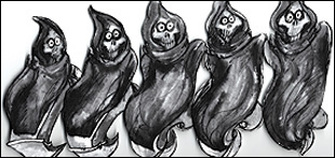
DON'T FORGET TO BRING YOUR EYES (1993)
Visual media: Edited frame by frame, 30 frames per second on NTSC standard SVHS 1/2inch videocassette tape (refer to THE IRRITANTS EYE WAX notes).
Animation techniques: 2D traditional, hand drawn animation with pencil, chalk pastel, and pen and ink on paper; Stop-motion with a character made of paper, wire and acrylic paint on miniature settings, paper cut-outs, modeling clay, yarn, a light bulb, a wooden chair, a dancing skeleton music box, raw chicken meat, and humans.
Audio: The same cheap-ass method used for LEFT TO WRITE, but substituting SVHS for VHS.
Soundtrack: Possibly circa 1920's, the soundtrack music is a 78 rpm recording of LOOK WHAT YOU'VE DONE WITH YOUR DOG-GONE DANGEROUS EYES penned by infamous 20th century songwriters, Bert Kalmar and Harry Ruby. Sound effects by THE IRRITANTS.
Notes: Several illustrations by artist John Tenniel from Lewis Carroll's surreal masterpiece, ALICE'S ADVENTURES IN WONDERLAND, were incorporated into this piece to alert the audience of the hypocritical and insane nature of its theme with some immediately recognizable images of unforgiving, satirical fantasy. Yes, that is Dean, adorned with cardboard cartoon eyes and teeth, spazzing in front of Tenniel's MAD TEA PARTY image, which Dean painted on his living room wall in Lake Bluff, Illinois. Production took a period of seven months ending August 1993. DON'T FORGET TO BRING YOUR EYES was re-mastered to digital media at RELEVANT IMPERTINENCE PRODUCTIONS and the original 2 track audio mix was re-mastered by Matt Fry at ULTRASUEDE Studio, both in Cincinnati, during late 2002-early 2003.
Visual media: Edited frame by frame, 30 frames per second on NTSC standard SVHS 1/2inch videocassette tape (refer to THE IRRITANTS EYE WAX notes).
Animation techniques: 2D traditional, hand drawn animation with pencil, chalk pastel, and pen and ink on paper; Stop-motion with a character made of paper, wire and acrylic paint on miniature settings, paper cut-outs, modeling clay, yarn, a light bulb, a wooden chair, a dancing skeleton music box, raw chicken meat, and humans.
Audio: The same cheap-ass method used for LEFT TO WRITE, but substituting SVHS for VHS.
Soundtrack: Possibly circa 1920's, the soundtrack music is a 78 rpm recording of LOOK WHAT YOU'VE DONE WITH YOUR DOG-GONE DANGEROUS EYES penned by infamous 20th century songwriters, Bert Kalmar and Harry Ruby. Sound effects by THE IRRITANTS.
Notes: Several illustrations by artist John Tenniel from Lewis Carroll's surreal masterpiece, ALICE'S ADVENTURES IN WONDERLAND, were incorporated into this piece to alert the audience of the hypocritical and insane nature of its theme with some immediately recognizable images of unforgiving, satirical fantasy. Yes, that is Dean, adorned with cardboard cartoon eyes and teeth, spazzing in front of Tenniel's MAD TEA PARTY image, which Dean painted on his living room wall in Lake Bluff, Illinois. Production took a period of seven months ending August 1993. DON'T FORGET TO BRING YOUR EYES was re-mastered to digital media at RELEVANT IMPERTINENCE PRODUCTIONS and the original 2 track audio mix was re-mastered by Matt Fry at ULTRASUEDE Studio, both in Cincinnati, during late 2002-early 2003.
QUEER AND LOATHING (1995)
Visual media: Edited frame by frame, 30 frames per second on NTSC standard SVHS 1/2inch videocassette tape (refer to THE IRRITANTS EYE WAX notes).
Animation techniques: 2d traditional, hand drawn and painted animation with marker and watercolor on paper.
Audio: That damn method used for LEFT TO WRITE, but substituting SVHS for VHS.
Soundtrack: Originally, David B. Feinberg was recorded speaking his own text for the sequences, but the producers decided against his monotone delivery and re-recorded the parts with an actor. The little theme music and the sound effects were not surprisingly products of THE IRRITANTS.
Notes: Due to the success of his 1992 work, NUMBERING BAD FRUIT, Dean was offered a commission to direct and animate several excerpts from Mr. Feinberg's book for POSITIVE: LIFE WITH H.I.V., a four-part public television series. Despite critical acclaim, the series was only shown sporadically around the United States in early 1995.
Visual media: Edited frame by frame, 30 frames per second on NTSC standard SVHS 1/2inch videocassette tape (refer to THE IRRITANTS EYE WAX notes).
Animation techniques: 2d traditional, hand drawn and painted animation with marker and watercolor on paper.
Audio: That damn method used for LEFT TO WRITE, but substituting SVHS for VHS.
Soundtrack: Originally, David B. Feinberg was recorded speaking his own text for the sequences, but the producers decided against his monotone delivery and re-recorded the parts with an actor. The little theme music and the sound effects were not surprisingly products of THE IRRITANTS.
Notes: Due to the success of his 1992 work, NUMBERING BAD FRUIT, Dean was offered a commission to direct and animate several excerpts from Mr. Feinberg's book for POSITIVE: LIFE WITH H.I.V., a four-part public television series. Despite critical acclaim, the series was only shown sporadically around the United States in early 1995.
SPURT (2001)
Visual media: The original hand drawn images were prepared at 30 frames per second, individually scanned into an APPLE MACINTOSH computer, logged and compiled in the RETAS! PRO 2D animation program, then exported in QUICKTIME format to the FINAL CUT PRO editing program.
Animation techniques: 2d traditional, hand drawn animation with marker on paper.
Audio: silent
Note: This short piece was the first work to be completed at the digitally upgraded RELEVANT IMPERTINENCE PRODUCTIONS studio in Cincinnati.
Visual media: The original hand drawn images were prepared at 30 frames per second, individually scanned into an APPLE MACINTOSH computer, logged and compiled in the RETAS! PRO 2D animation program, then exported in QUICKTIME format to the FINAL CUT PRO editing program.
Animation techniques: 2d traditional, hand drawn animation with marker on paper.
Audio: silent
Note: This short piece was the first work to be completed at the digitally upgraded RELEVANT IMPERTINENCE PRODUCTIONS studio in Cincinnati.

MEAT FOR FLIPPY (2001)
Visual media: The original hand drawn and painted images were prepared at 30 frames per second, individually scanned into an APPLE MACINTOSH computer,logged and compiled in the RETAS! PRO 2D animation program, then exported in QUICKTIME format to the FINAL CUT PRO editing program.
Animation techniques: 2d traditional, hand drawn animation with pencil and gouache on paper.
Audio: silent
Notes: Dean comments that Flippy is “carnivorous, hungry, and happy. And possibly Dutch.”
Visual media: The original hand drawn and painted images were prepared at 30 frames per second, individually scanned into an APPLE MACINTOSH computer,logged and compiled in the RETAS! PRO 2D animation program, then exported in QUICKTIME format to the FINAL CUT PRO editing program.
Animation techniques: 2d traditional, hand drawn animation with pencil and gouache on paper.
Audio: silent
Notes: Dean comments that Flippy is “carnivorous, hungry, and happy. And possibly Dutch.”
MADNESS METHOD (2001)
Visual media: The original hand drawn and painted images were prepared at 30 frames per second, individually scanned into an APPLE MACINTOSH computer, logged and compiled in the RETAS! PRO 2D animation program, then exported in QUICKTIME format to the FINAL CUT PRO editing program.
Animation techniques: 2d traditional, hand drawn animation with pencil and watercolor on paper.
Audio: silent
Notes: Dean's inspiration for this work was the incomprehensible inauguration of George W. Bush as President of The United States of America in January of 2001.
Visual media: The original hand drawn and painted images were prepared at 30 frames per second, individually scanned into an APPLE MACINTOSH computer, logged and compiled in the RETAS! PRO 2D animation program, then exported in QUICKTIME format to the FINAL CUT PRO editing program.
Animation techniques: 2d traditional, hand drawn animation with pencil and watercolor on paper.
Audio: silent
Notes: Dean's inspiration for this work was the incomprehensible inauguration of George W. Bush as President of The United States of America in January of 2001.
GOODBYE CRUEL YOUTH (2003)
Visual media: The original hand drawn and painted images were prepared at 30 frames per second, individually scanned into an APPLE MACINTOSH computer, logged and compiled, and layered in the RETAS! PRO 2D animation program, then exported in QUICKTIME format to the FINAL CUT PRO editing program.
Animation techniques: 2d traditional, hand drawn animation with pencil and gouache on paper.
Audio: silent
Notes: The piece was created, in part, as a test of scanned-in artwork layered 3-Dimensionally for the recently acquired digital technology at Dean's studio, RELEVANT IMPERTINENCE PRODUCTIONS in Cincinnati.
Visual media: The original hand drawn and painted images were prepared at 30 frames per second, individually scanned into an APPLE MACINTOSH computer, logged and compiled, and layered in the RETAS! PRO 2D animation program, then exported in QUICKTIME format to the FINAL CUT PRO editing program.
Animation techniques: 2d traditional, hand drawn animation with pencil and gouache on paper.
Audio: silent
Notes: The piece was created, in part, as a test of scanned-in artwork layered 3-Dimensionally for the recently acquired digital technology at Dean's studio, RELEVANT IMPERTINENCE PRODUCTIONS in Cincinnati.
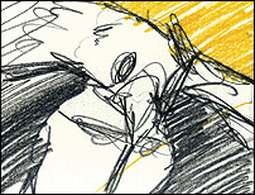
WEED THE PEOPLE (2003)
Visual media: The original hand drawn images were prepared at 30 frames per second and videotaped individually and successively on a Canon GL1 Digital Video camera, not entirely unlike Dean's earlier, primitive method of production (refer to THE IRRITANTS EYE WAX notes). The images were then input, logged, and compiled in the RETAS! PRO animation program on an APPLE MACINTOSH computer, exported to QUICKTIME format, and mastered in the FINAL CUT PRO editing program.
Animation techniques: 2d traditional, hand drawn animation with pencil and coffee on paper, incorporating hand held mattes of paper stained with coffee, and cut cels with acrylic ink.
Audio: The music was digitally recorded by Matt Fry at ULTRASUEDE Studio in Cincinnati. The sound effects were homemade on a portable SONY MINIDISC 8-track system and edited in the FINAL CUT PRO program at RELEVANT IMPERTINENCE PRODUCTIONS, also in Cincinnati. The piece was mixed and mastered by award-winning sound designer Will Riley at PLANET OF IDIOTS, Hollywood.
Soundtrack: Music and sound effects created by THE IRRITANTS.
Notes: Dean drew the entire piece on a standard office stock clipboard. Begun in April of 1996, the drawings took an estimated three and one half years to complete. The digitizing of these drawings took Dean and his assistants embarrassingly another grueling two years, having to learn all implemented computer wizardry from scratch.
Visual media: The original hand drawn images were prepared at 30 frames per second and videotaped individually and successively on a Canon GL1 Digital Video camera, not entirely unlike Dean's earlier, primitive method of production (refer to THE IRRITANTS EYE WAX notes). The images were then input, logged, and compiled in the RETAS! PRO animation program on an APPLE MACINTOSH computer, exported to QUICKTIME format, and mastered in the FINAL CUT PRO editing program.
Animation techniques: 2d traditional, hand drawn animation with pencil and coffee on paper, incorporating hand held mattes of paper stained with coffee, and cut cels with acrylic ink.
Audio: The music was digitally recorded by Matt Fry at ULTRASUEDE Studio in Cincinnati. The sound effects were homemade on a portable SONY MINIDISC 8-track system and edited in the FINAL CUT PRO program at RELEVANT IMPERTINENCE PRODUCTIONS, also in Cincinnati. The piece was mixed and mastered by award-winning sound designer Will Riley at PLANET OF IDIOTS, Hollywood.
Soundtrack: Music and sound effects created by THE IRRITANTS.
Notes: Dean drew the entire piece on a standard office stock clipboard. Begun in April of 1996, the drawings took an estimated three and one half years to complete. The digitizing of these drawings took Dean and his assistants embarrassingly another grueling two years, having to learn all implemented computer wizardry from scratch.


